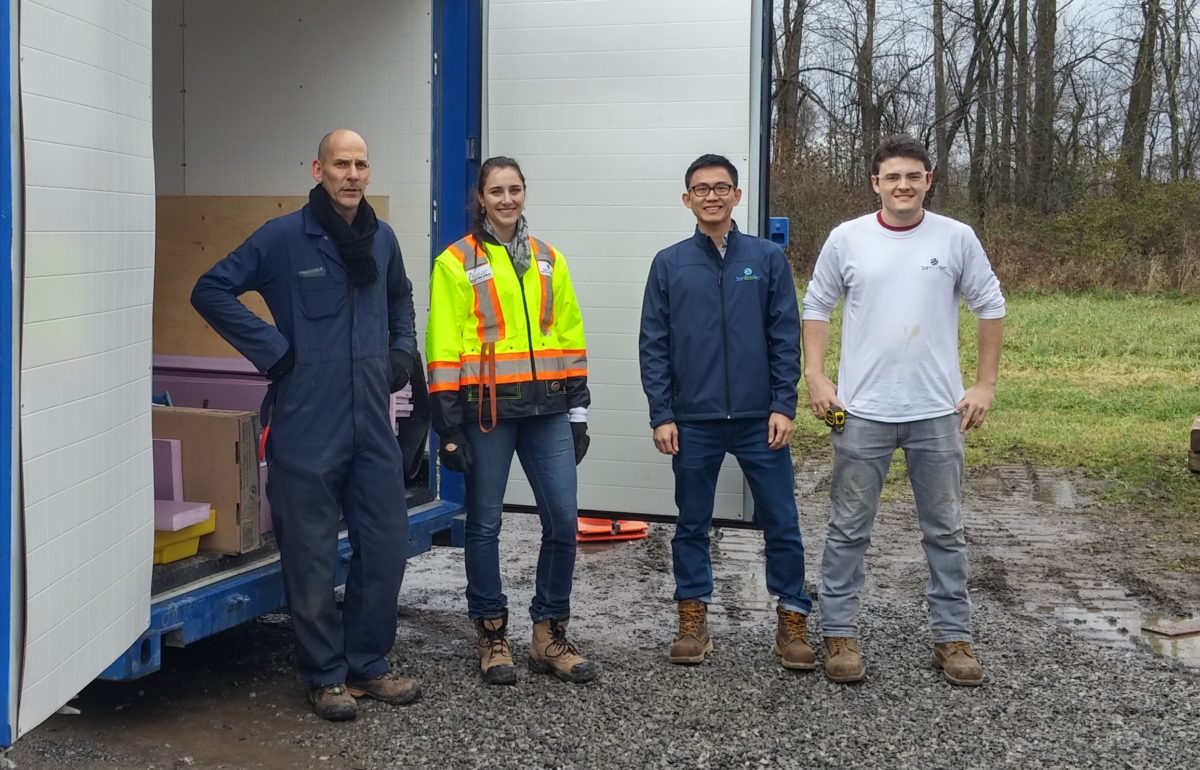SanEcoTec, an Ottawa-based company, has developed a water treatment system that it believes can meet the myriad challenges facing North America’s water industry, using a substance similar to one found in most medicine cabinets.
With support from Southern Ontario Water Consortium’s Advancing Water Technologies (AWT) program, which is funded by the Federal Economic Development Agency for Southern Ontario (FedDev Ontario), the company is moving toward commercializing the system — and perhaps a new paradigm for water treatment.
SanEcoTec’s AVIVE™ process uses a new generation of stabilized hydrogen peroxide called Huwa-San® peroxide or HSP. Hydrogen peroxide has been used for years in food production and organic farming. It’s safe for consumption and breaks down harmlessly into oxygen and water.
HSP doesn’t create the harmful disinfection by-products (DBPs) that are produced when the chlorine used in conventional water treatment systems interacts with organic matter. In fact, it’s been shown to reduce DBPs by up to 70%. HSP also works more effectively over a wider range of water types and temperatures. And since it’s much less corrosive than chlorine, it’s safer for pipes, tanks and other infrastructure.
But the AVIVE system involves more than just stabilized peroxide, says Els Vanbeckevoort, SanEcoTec’s Co-Founder and CEO.
“This is about the equipment, the methodology and the control capabilities that AVIVE offers. AVIVE integrates easily with existing water treatment processes and actually makes them more effective in terms of water quality, energy savings and maintenance. It doesn’t just improve secondary disinfection. It affects the whole treatment process from beginning to end.”
A crucial step in commercialization
Now, with funding through AWT, SanEcoTec and its research partners at Queen’s University have launched a project to study how the microorganisms in a drinking water distribution network change when the treatment system switches from chlorine to HSP.
Steven Liss is the project’s lead investigator. A Professor Emeritus at Queen’s, he currently holds an adjunct position in the Department of Environmental Studies; he is also a professor of Chemistry and Biology at Ryerson University. Liss co-authored the study that first showed HSP’s efficacy as a secondary disinfectant in a water distribution system.
“SanEcoTec’s AWT project is a crucial step in the commercialization of the AVIVE process,” he says. “We need to fully understand and demonstrate the changes in the microbiome in order to advance the technology from the pilot stage to full, commercial acceptance.”
Toward a safer, healthier water supply
Milltown, Newfoundland, is a small community that’s dealing with numerous challenges to its water supply, from extreme weather to higher-than-acceptable levels of DPBs. In 2017, the town agreed to install AVIVE technology and become a test site for the SanEcoTec’s AWT project.
In collaboration with SanEcoTec’s engineers, Liss’ research team conducted testing to determine a baseline before the installation of a portable version of the AVIVE technology called WaterShed™. This prebuilt, independent water treatment package contains monitoring and dosing equipment and connects easily to existing water distribution systems.
Now the team is continuing its analysis with the goal of demonstrating that the microorganisms that develop in the AVIVE system are as safe, or potentially safer, than those found in a conventional treatment system.
“Ultimately, we hope to establish a microbiology control methodology that will allow SanEcoTec to develop new applications for AVIVE,” says Liss.
A new paradigm
This is an exciting time for SanEcoTec. The company has five years’ worth of data from past pilot projects in municipal systems and six patents in progress.
“The AWT project will contribute to the body of knowledge we’ve built over the past 10 years and allow us to demonstrate that AVIVE meets all requirements, in the lab and in the field,” says Vanbeckevoort.
“But pilot projects like this are a huge investment for early commercialization companies, like ours, to make. Having access to science partners like Steven Liss and his team, as well as funding, is absolutely critical.”
Liss adds that through the AWT funding, “we have access to a piloting facility and tools that allow us to collect data that we wouldn’t otherwise be able to acquire. And on a larger scale, by supporting collaboration between universities and industry, funding programs like AWT allow Canadian companies to increase their capacity for research and development in-house and, as a result, their global competitiveness.”
As the data that demonstrates AVIVE’s effectiveness mounts, new opportunities have opened up for SanEcoTec. The company is reaching out to markets in the US and has been approached by potential venture partners in Europe.
But financial achievement isn’t the bottom line.
“Existing water treatment methods can’t address the emerging issues around energy, contaminants, and climate change. Regulators need to create new standards,” says Vanbeckevoort.
Not only are more stringent standards possible due to the emergence of innovative technologies, but implementing them will also drive the market for such approaches.
“We’re on the brink of a shift and we hope to join global partners to help lead the development of a new water treatment paradigm. That would mean success for us — not just for our company, but for our province and our country.”


